New Zealand’s most popular cycling trail is truly epic
Given the name “Alps to Ocean”, you’d be forgiven for assuming that New Zealand’s longest Great Ride is all downhill. It’s not. There are several testing climbs, the most challenging being a five-kilometre ascent on a narrow, organ-jumbling trail that leads to the ride’s loftiest point, the 900-metre-high summit of Tarnbrae Saddle. Even for those of us on e-bikes, it’s a grind, but the view from the top is just reward – a yawning vista that includes the sparkling blue waters of Lake Ohau and the soaring flanks of its glacier-carved valley.
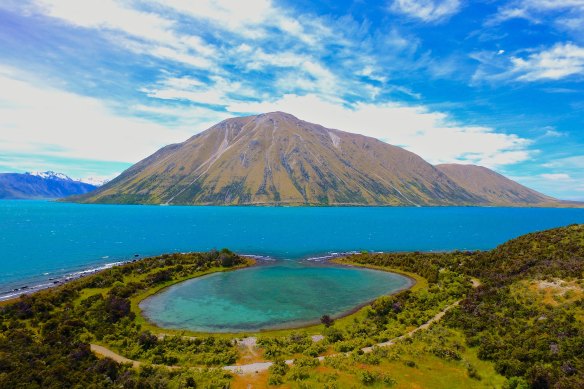
New Zealand’s Alps to Ocean bike ride offers many rewarding views.
To be fair, the climb is optional, and several of our group have chosen to be bussed around to Quailburn woolshed, where we’ll meet again for afternoon tea. It’s one of the many benefits of this six-day guided tour with Adventure South. Not only is our luggage whisked between hotels each day, but the support van is never far away should someone have a mechanical issue or decide they want to opt out of a leg.
Opting out isn’t a phrase in 78-year-old Rowan McKeon’s vocabulary. A retired teacher from Victoria’s Dandenong Ranges, he cheerfully tackles everything the trail throws at us, moseying along at his own pace and clearly enjoying every minute of it. “I keep asking my body to do things,” he tells me one night over dinner, “and to my surprise it keeps saying yes.”
Geological wonderland
It’s hard to think of another six-day ride that delivers such an impressive variety of terrain. There are two official starting points, one in Mount Cook Village under the lofty glare of New Zealand’s highest mountain, and another in Tekapo, a small township on the shores of Lake Tekapo. Adventure South offers departures from both, with the former including an exhilarating – but weather-dependent – helicopter transfer over the Tasman River.
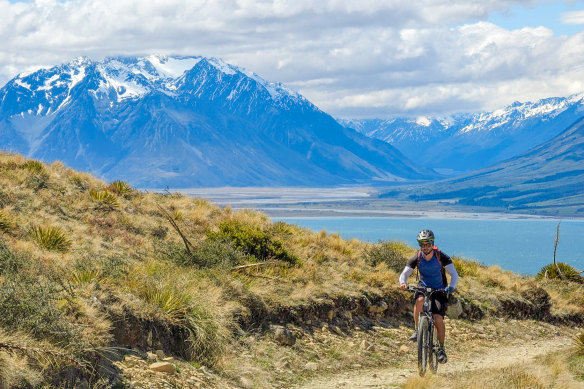
The six-day ride delivers an impressive variety of terrain.
We’re on the latter, slightly shorter itinerary (296 kilometres v 316), so begin our trip with a night in Tekapo, an attractive town that by day offers captivating views over the turquoise-hued lake and by night provides spectacular stargazing thanks to its location within the Aoraki Mackenzie International Dark Sky Reserve.
We’re in the heart of Mackenzie Country, a semi-arid elevated plateau in the centre of the South Island that’s surrounded by mountains. It should be famous for being the country’s largest elliptical intermontane basin, but is better known for being named after Scottish sheep rustler James McKenzie.
From here, the trail heads southwest to Twizel and Omarama, before veering southeast to follow the Waitaki River towards Oamaru on the coast. Along the way, it skirts several large natural and artificial lakes, including Lake Pukaki, Lake Ohau, Lake Benmore and Lake Aviemore, which form the backbone of a complex system of hydroelectric dams and canals. Cycling next to a man-made hydro-canal might not sound like the most enthralling experience, but on a clear, crisp morning, cruising along a quiet, canal-side path towards a horizon studded with the snow-capped Southern Alps turns out to be some of the loveliest cycling I’ve done.
We encounter a geologist’s dream of noteworthy formations, including visible terracing on the hillsides above Lake Ohau that were created by a glacier as it repeatedly advanced and retreated along the valley. At the end of the lake are some of the world’s best examples of terminal moraines – 18,000-year-old piles of debris that mark the glacier’s furthest advance.
Following the Waitaki Valley towards the coast, we plunge into a dramatic world of limestone gullies that harbour a treasure trove of remarkably well-preserved fossils, including the jawbone of a 25-millon-year-old baleen whale that’s on display near Duntroon.
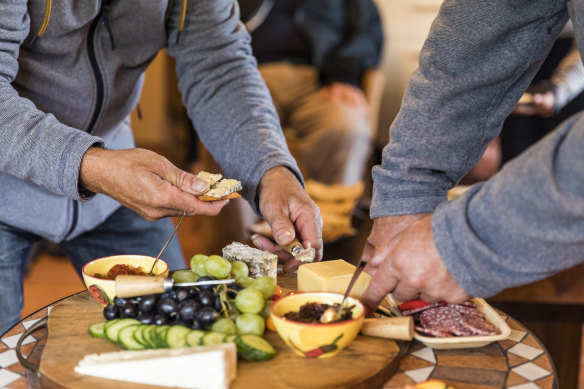
Fuel for the ride.
There’s evidence of Maori activity here too, particularly at Takiroa, a limestone cliff bearing red ochre and charcoal rock art dating from about 1400AD. Unfortunately, a lot of it has been removed for display in museums and what’s left is a little underwhelming. Or, as one booming American announces on his way out, “That’s the most disappointing cave art I’ve ever seen.”
Still, the combination of the valley’s Maori heritage, notable fossil record and unique geology was enough to convince UNESCO to declare it Australasia’s first Global Geopark, in 2023.
Guiding lights
Shepherding us through this remarkable landscape are guides Sam Prior and Henry Conquer, who alternate between cycling and driving the support van. I’ve done several trips with Adventure South and am always amazed at how passionate, knowledgeable and capable the guides are, particularly ones like Prior and Conquer, who are both in their early 20s – an age at which I could barely tie my own shoelaces, let alone explain complex geological formations and reverse a van with a trailer attached.
Each day we rendezvous with the vehicle at regular intervals, including morning and afternoon tea, which is served with an impressive assortment of fresh fruit and sweet treats. Lunches are normally a takeaway sandwich savoured in a scenic spot, occasionally accompanied by a breath-stealing dip in a glacial lake. Dinners are hearty regional feasts in a local restaurant with a glass or three of excellent local pinot.
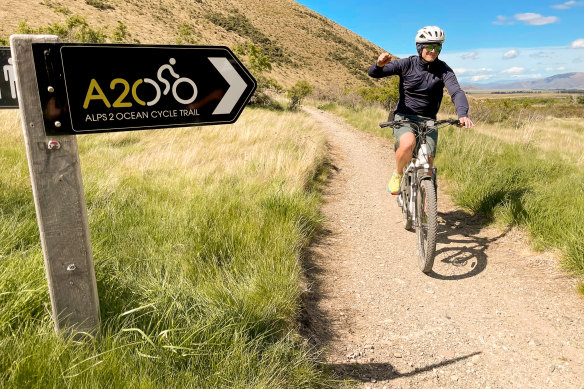
E-bikes make the trip less painful.
Of the 11 people in the group, six of us are using e-bikes, which have the obvious advantages of making the ascents less painful and allowing people of different abilities to cycle together. Two less-publicised disadvantages are that you tend to eat the same amount as if you were on a normal bike (so don’t expect to lose any weight) and you’ll still need to spend about six hours a day getting intimately acquainted with a backside-tenderising saddle (so don’t skip the pre-trip training).
On average, we cover about 60 kilometres a day on either quiet backroads or well-maintained gravel bike paths. Most of the more challenging single track sections are optional, but they’re also the most exciting and scenic parts of the trip. Despite celebrating its 10-year anniversary last year, the trail is still evolving, and in December 2020, a dramatic section was opened through Bog Roy Station that traverses high above the emerald waters of Lake Benmore. It’s arguably one of the finest pieces of single track in the country and naturally Rowan is at the front of our group.
Given the popularity of the Alps to Ocean trail, I’m amazed we don’t see more people on it. Part of the reason is that the departures of the big tour operators are strategically staggered to keep groups apart. The other factor is that very few people attempt it in reverse (cycling the “Ocean to Alps” has an alarmingly uphill ring to it), so you scarcely encounter anyone coming the other way. As a Kiwi I meet at a lookout one day overlooking Lake Benmore puts it, “It feels like we’re the only ones on the planet, eh?”
Regional gems
One of the great joys of a trip like this is the intriguing small towns you visit along the way. Once the terminus of a now-defunct railway line, Duntroon is a classic example of a place that’s enjoying a new lease of life thanks to the trail. During a coffee stop at the Barbie-pink Flying Pig Cafe, there’s time to explore the town’s improbable bounty of attractions, which include the Vanished World Centre, a museum containing hundreds of fossils collected by local farmers (including several giant moa bones); a working blacksmith’s; a spooky, mannequin-filled restored jail; a fantastic wetlands walk full of native plants and quite possibly New Zealand’s fanciest public toilets. Not bad for a town of 96 people.
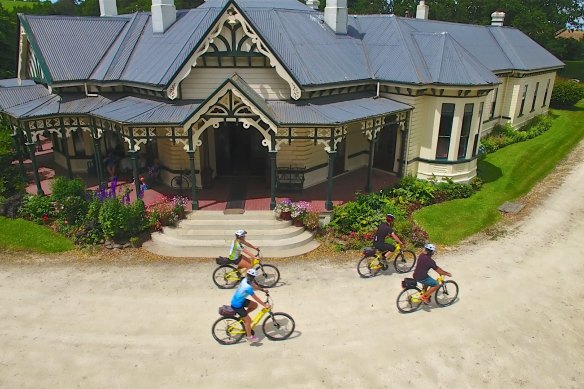
Oamaru is a beautifully preserved Victorian shopping precinct.
Our end point of Oamaru is a much more established tourist drawcard. The largest town in the Waitaki District, it’s known for its beautifully preserved Victorian shopping precinct, radical steampunk museum and colony of adorable little blue penguins.
For us, it marks the end of an almost 300-kilometre journey from the foothills of the Southern Alps to the foreshore of the Pacific Ocean. We celebrate with a group photo at the official finish marker, a giant photo frame overlooking Oamaru Harbour. All in all, it’s been an epic trip – perhaps the most enjoyable multi-day cycle ride I’ve ever done. Even if it wasn’t all downhill.
The details
Fly
Air New Zealand and Qantas both fly to Christchurch. See airnewzealand.com.au; qantas.com
Tour
Starting and ending in Christchurch, the six-day Alps to Ocean Classic trip includes five nights’ accommodation, most meals and full vehicle support, from $NZ2895 ($2690) a person. Guests can bring their own bike or hire one for $NZ180 ($NZ600 for an e-bike). See adventuresouth.co.nz
The writer was a guest of Tourism New Zealand (newzealand.com) and Adventure South.
Sign up for the Traveller Deals newsletter
Get exclusive travel deals delivered straight to your inbox. Sign up now.